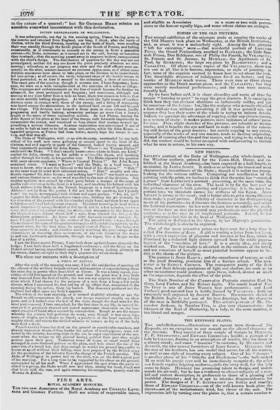NEW PRINTS.
Lusee's portrait of the Duke of Wellington—the whole-length, in the Windsor uniform, painted for the Town-Hall, Dover, and ex- hibited at the Royal Academy—has been engraved as a balf.length, in mezzotint, by JAMES SCOTT. It strikes us as being the truest and most characteristic resemblance of the Duke; though it is rather too young- looking for the veteran soldier. Comparing our recollection of the painting with the print, we incline to think that the artist has "snatched a grace" from LAWRENCE'S portrait : preserving, at the same time, the individual character of his own. The head is by far the best part of the picture, as regards both painting and engraving: it is the most im- portant too; we therefore excuse the stiffness of the figuie. JOHN LILLEY is young at time easel; and is better able to get a strong likeness than make a good picture. Fidelity of character is the distinguishing merit of his portraits—be delineates the features accurately, and seizes the habitual expression : he has now to learn how to subdue the mark- ings of the face so that the mental may predominate over the physical qualities ; as is the case in ill intellectual portraits. Ind.2ed, he has partly accomplished this in the bead of Wellington. The print is dedicated to the Queen, by her Majesty's permission. The whole-length is also to be engraved.
One of the most attractive prints we have seen for a long time is called The Sunshine qf Love. A girl is reading a letter from her lever, with a sweet expres.ion of pleasure and interest in her fuee, which is illumined by a reflected light thrown upward from the white paper typicalof the " sunshine of love." It is a pretty idea, and nicely worked out. The fair reader is absorbed in the contents of the letter, and not conscious of herself as most pictorial heroines appear to be : this is the charm of the picture.
The painter is JOHN RAOUX; and the smoothness of texture, as well as the good drawing, proclaim him of a foreign school. The mez- rmint is by SAmeet. COUSINS. The transparent purity of the flesh tints, and their delicate gradations of light and shadow, are such as no other mezzotinter could produce: upon these, indeed, almost as much as the expression, depends the effect of the print.
The Sixth Number of the Conservative Portraits contains Earl De Grey, Lord Forbes, and Sir Robert Inglis. The manly head of Earl De Grey is one of JOHN WOOD'S best performances ; and Lord Forbes's good-natured face is boldly 'Mined by FAULKNER : both are extremely well engraved by Jossrit hiltowN. Ricnatoeles sketch of Sir Hubert Inglis is not one of his best drawings, but the character of the man is faithfully portrayed. This artist's portrait of Mr. De- vonsher Jackson, in Number Five, is also very characteristic : the likeness of the Earl of Harrowby, by a lady, in the same number, is too literal and meagre.


























 Previous page
Previous page